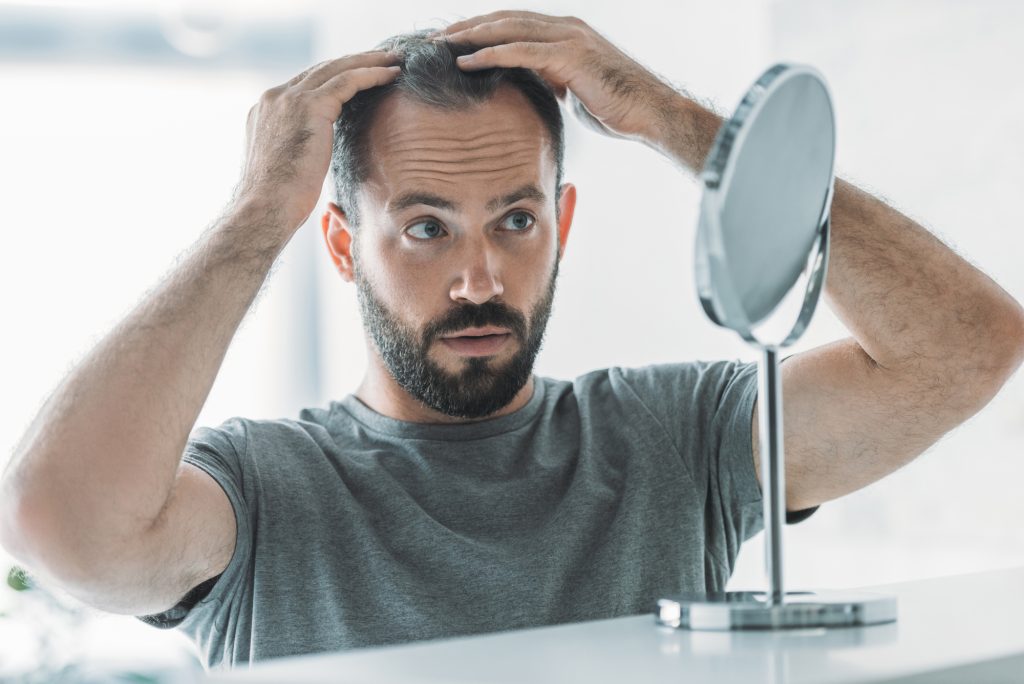
The condition known as male-pattern baldness affects a significant number of males all over the world. It is characterised by a loss of hair on the scalp, which in certain cases can progress all the way to baldness. Male-pattern baldness is a condition that is frequently connected with ageing; however, genetics also play a key part in the development of the condition. In this blog post, we will discuss the role that genetics play in male-pattern baldness and what the findings of scientific research on the issue have revealed about it.
What Is the Male Pattern of Baldness?
Androgenetic alopecia, more often known as male-pattern baldness, is a disorder that manifests itself in males as they get older. It is characterised by a loss of hair on the scalp, which in certain cases can progress all the way to baldness. A sensitivity to the hormone dihydrotestosterone (DHT), which causes hair follicles to shrink and, eventually, stop creating new hair, is the root cause of this disorder. Genetics plays a significant role in determining whether or not a person will experience male-pattern baldness, and there are multiple genes that contribute to the condition’s progression.
How Do Genetics Affect Male-pattern Baldness?

The androgen receptor gene and the aromatase gene, both of which are involved in the metabolism of testosterone and oestrogen, are two of the genes that have been found through scientific research as being connected with male-pattern baldness.
A number of studies have been conducted in order to identify particular genetic variants that are connected to differences in baldness. In most cases, the AR gene has been found to demonstrate the highest correlation.
Using a gene-based approach, researchers were able to identify 112 autosomal genes and 13 X chromosome genes that are related with baldness.
Recent research conducted by scientists at the University of Bonn identified 63 genetic variants linked to male-pattern baldness, 22 of which are considered to be novel 1. More than 22,000 individuals’ data were used for the study, with about 17,000 of those individuals being clients of 23andMe(online DNA Genetic testing website) who gave their agreement to participate in the research. These genetic variations, which the researchers discovered are likely involved in the biological process that leads to balding and which could be viable therapeutic targets for treating the condition, were discovered by the researchers.
Can Male-Pattern Baldness Be Predicted Based on Genetics?
The development of male-pattern baldness can be forecasted to some extent by genetics, according to research. According to the findings of a study that looked at the baldness gene in twins, genetics are responsible for eighty percent of male-pattern baldness. The research also discovered that male-pattern baldness is polygenic, meaning that it can be caused by more than one gene at a time. In another study, the researchers developed a polygenic predictor that could differentiate between people who had no hair loss and people who had a significant amount of hair loss.
How to Treat Male-Pattern Baldness?
Minoxidil and finasteride are two medications commonly used to treat hair loss. They work in different ways to help maintain hair density and stimulate hair growth.
Minoxidil is a topical solution that stimulates blood flow to the hair follicles, promoting healthy hair growth. It works by directly stimulating the hair follicles and affecting their growth cycle. Minoxidil has been shown to shorten the resting stage of the hair cycle, preventing hair shedding and maintaining the growing phase of the hair cycle. It can also help reverse hair loss by improving blood flow to the hair follicles
On the other hand, finasteride works by reducing the effects of dihydrotestosterone (DHT) on the hair follicles. DHT is a hormone that contributes to hair loss by inducing changes in the affected follicles, leading to thinning, receding hairlines, and baldness. Finasteride inhibits the activity of the 5-alpha reductase enzyme, which is responsible for the conversion of testosterone into DHT. By blocking this conversion, finasteride helps prevent further hair loss.
If you’re seeking a remedy that will last a lifetime, you might want to think about getting a hair transplant. The effects of a hair transplant can be permanent and appear to be completely natural today. There are multiple methods of hair transplantation that can achieve successful results such as FUE and FUT methods.
The FUE technique involves harvesting healthy hair follicles from the scalp, and grafting them directly on to the bald and thinning areas of your head. Although the transplanting principle sounds the same as previous techniques, the FUE technique achieves a more natural look without leaving any visible scars.
During a FUT procedure, a surgeon makes a skin incision on the side or back of your head and removes individual hair follicles. After that, these follicles are implanted into the areas of your scalp that are balding. Follicular unit transplantation is the procedure that replaced minigraft and punch graft methods.
GetHair provides clients with the opportunity to benefit from the optimal combination of cutting-edge procedures and more than 20 years of professional experience in the field of hair transplantation.
Get a free consultation from our experienced doctors and start the first step on your trip to a more youthful appearance, which is guaranteed by our unparalleled level of professional expertise.
Conclusion
In conclusion, male pattern baldness is a prevalent condition that impacts a significant number of males all over the world. Male-pattern baldness is a disorder that is frequently connected with ageing; however, genetics also play a key part in the development of the condition. Genetics can be used to make some accurate predictions about male-pattern baldness, as scientific research has uncovered a number of genes that are connected with the disorder. In order to completely understand the underlying causes of male-pattern baldness and to design therapies that are successful, additional research is required.
Sources:
https://www.ncbi.nlm.nih.gov/pmc/articles/PMC5308812/
https://onlinedoctor.lloydspharmacy.com/uk/hair-loss-advice/using-finasteride-and-minoxidil-together
